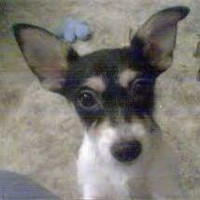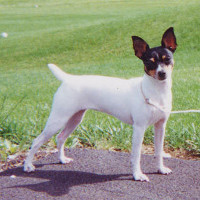 |
Fo-Chon |
|
He is not recognized by the F.C.I. |
Origin |
France / Belgium <> U.S.A. -> U.S.A. | |
Translation |
Francis Vandersteen | |
This breed is also known as |
Toy Fo-Chon |
A brief presentation of the Fo-Chon |
| Your Fo-Chon is a cross between a Bichon Frise and a Toy Fox Terrier. As both are small dogs, the Fo-Chon will also be a small dog, weighing around 4 kilos and averaging 25.5 centimeters in length. Their coats are thick and of medium length, and are generally curly or frizzy because of the curly coat of the Bichon à poil frisé. The Fo-Chon is a fun, active dog that loves family and gets along well with everyone. However, they tend to be protective of their owners and will make a good watchdog. They need patience with training as they can be a little stubborn. |
History of the Fo-Chon |
| To understand this seemingly rare but adorable hybrid breed, it's crucial to understand its origins. Knowing the parents of a mixed breed, both in type and in size and temperament, can shed light on what you can expect from a specific litter of mixed puppies. The Fo-Chon is a cross between the Bichon à poil frisé and the Toy Fox Terrier. Size, physical appearance and temperament are mainly based on these two breeds. After all, a hybrid breed is designed to bring out the best qualities of both parent breeds. |
A little of the Bichon frise |
||
| The Bichon Frise is thought to have originated in ancient times, but was introduced to France in the 14th century under the name Barbichon, which is French for curly coat. Their first relative is the Water Spaniel or Barbet, and others include the Maltese and Poodle. There were four types of Bichon, including the Tenerife Bichon, Havanese Bichon, Bolognese Bichon and Maltese Bichon. The Bichon à poil frisé came from the Bichon Tenerife, which was named after the island of Tenerife, where they were found. The breed was popular with Spanish sailors and was used to barter other items. In the 1300s, Italian sailors brought the little dogs to Italy, where they attracted the attention of royalty, and when the French invaded Italy, the Bichon à poil frisé became a popular pet of Henri III. In fact, he wore his sideburns in a basket around his neck. In the 1800s, it was discovered that this breed was highly intelligent and could learn to do tricks, and was used in the circus or as street performers. The Bichon Frise was not officially recognized by the American Kennel Club (AKC) until 1972, but it is now the 45th most popular breed in America. | ||
 |
||
| Standard of the Bichon frise | ||
A little of the Toy Fox Terrier |
||
| The Toy Fox Terrier was originally developed in the USA in the 1930s, where it was mainly used to hunt rats, mice and squirrels. It was bred from the Smooth Fox Terrier, Manchester Terrier, Miniature Pinscher, Italian Greyhound and other small toy breeds such as the Chihuahua. They were registered with the AKC in 2003 and are the 116th most popular dog breed in the USA. | ||
 |
||
| Presentation of the Toy Fox Terrier |
Appearance of the Fo-Chon |
| Your Fo-Chon will be a very small dog, measuring only around 20 to 30.5 centimeters in height and weighing between 2.5 and 6.5 kilos. They have a thick, medium to long coat that can be frizzy, curly, wavy or even straight in places. They can be black, brown, beige, white or any combination of these. This dog has a small head with a long muzzle and huge pointed ears. They are small in stature with slender legs and a long tail that may or may not be docked. They are athletic and have a long neck that makes them elegant and graceful with a lively expression. |
Temperament of the Fo-Chon |
| This breed will make an excellent pet and guard dog, but may need extra training to behave indoors. They tend to be strong-willed and may require a little patience to adapt to the home, even though they are extremely intelligent. The Fo-Chon loves children, but needs to be supervised as they can be aggressive if teased too much. Although they get on well with other dogs, you may need to socialize them as puppies to make them friendly to other pets such as cats. They contain hunting blood, so should not be left unattended with smaller animals such as ferrets, rabbits or small kittens. |
Needs and activities of the Fo-Chon |
| The Fo-Chon is a moderately active breed that needs 30 to 45 minutes of intense activity a day. They have a lot of nervous energy, which can build up and cause stress and anxiety if not used. In fact, if your dog doesn't get enough exercise, he may become bored and anxious enough to develop behavioral problems such as excessive chewing and barking. This breed loves to run and jump, and will do well with agility training, Frisbee, flyball, hiking, swimming and even trips to the dog park. However, you must first ensure that your dog is sufficiently socialized to get along with other dogs. |
Maintenance of the Fo-Chon |
| You should brush your Fo-Chon at least three or four times a week with a stiff bristle brush and a smoother brush. Be sure to go under the legs and neck to avoid knots and tangles. They tend to have skin allergies, so you should only use shampoos and other hair and skin products recommended by a vet. Don't bathe them often, as this causes them to lose sebum and dries out their skin. Clean their ears once a week with a damp cotton pad and watch for redness, mites and wax build-up. Trim their nails to prevent cracking and painful proliferation if necessary, and brush their teeth several times a week. |






 English (United Kingdom)
English (United Kingdom)